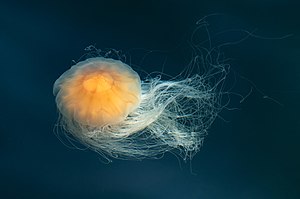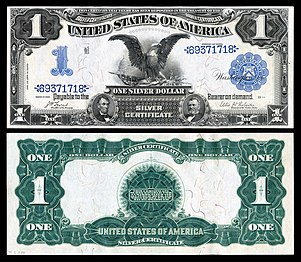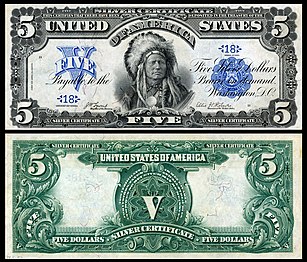|
Featured picture tools: |
These featured pictures, as scheduled below, appeared as the picture of the day (POTD) on the English Wikipedia's Main Page in July 2022. Individual sections for each day on this page can be linked to with the day number as the anchor name (e.g. [[Wikipedia:Picture of the day/July 2022#1]] for July 1).
You can add an automatically updating POTD template to your user page using {{Pic of the day}} (version with blurb) or {{POTD}} (version without blurb). For instructions on how to make custom POTD layouts, see Wikipedia:Picture of the day.
July 1

|
|
The willie wagtail (Rhipidura leucophrys) is a passerine bird native to Australia, New Guinea, the Solomon Islands, the Bismarck Archipelago, and eastern Indonesia. It measures about 19–21.5 cm (7+1⁄2–8+1⁄2 in) in length. The willie wagtail is insectivorous and spends much time chasing prey in open habitat. Its common name is derived from its habit of wagging its tail horizontally when foraging on the ground. Aggressive and territorial, the willie wagtail will often harass much larger birds such as the laughing kookaburra and wedge-tailed eagle. It has responded well to human alteration of the landscape and is a common sight in urban lawns, parks, and gardens. It is widely featured in Aboriginal folklore around Australia and New Guinea in a variety of roles, from stealer of secrets and liar to a good omen for successful crops. Photograph credit: JJ Harrison
Recently featured:
|
July 2

|
James A. Garfield (1831–1881) was the 20th president of the United States, serving from March to September 1881. On July 2, 1881, four months into his presidency, Garfield was shot at the Baltimore and Potomac Railroad Station in Washington, D.C., by Charles J. Guiteau, a disappointed and delusional office seeker. Garfield died two months later from infections caused by his doctors. He remains the only sitting member of the United States House of Representatives to be elected to the presidency. Photograph credit: unknown; restored by PawełMM and Quibik
Recently featured:
|
July 3

|
Les Troyens is a grand opera in five acts by Hector Berlioz with a French-language libretto written by the composer himself based on Virgil's Aeneid. The score was composed between 1856 and 1858, but Berlioz did not live long enough to see the work performed in its entirety. However, the last three acts, substantially abridged, were performed during his lifetime under the title Les Troyens à Carthage by Léon Carvalho's company, the Théâtre Lyrique, in Paris in 1863. For this performance, Berlioz added an orchestral introduction and a prologue. He was not happy with the result, noting bitterly that he had agreed to let Carvalho do it "despite the manifest impossibility of his doing it properly. He had just obtained an annual subsidy of a hundred thousand francs from the government. Nonetheless the enterprise was beyond him. His theater was not large enough, his singers were not good enough, his chorus and orchestra were small and weak." This is the cover of the piano–vocal score of Les Troyens, published in 1863 by Choudens, with a lithographic illustration by Antoine Barbizet. Lithograph credit: Antoine Barbizet; restored by Adam Cuerden
Recently featured:
|
July 4

|
|
The Ellis Island Immigrant Hospital (also known as USPHS Hospital No. 43) was a United States Public Health Service hospital on Ellis Island in New York Harbor that operated from 1902 to 1951. It is part of the Statue of Liberty National Monument. The hospital had two functions: treating immigrants who were ill upon arrival, and treating immigrants with conditions that were prohibited by immigration laws. These latter patients were stabilized and often sent back to their home countries. More than 275,000 patients were treated at Ellis Island; there were approximately 4,000 fatalities and 350 babies were born there. Efforts to restore the hospital buildings and other structures on the island are being made by the non-profit organization Save Ellis Island. This photograph depicts a window in the Ellis Island Immigrant Hospital, decorated in 2014 by the French artist JR with reproductions of photographs of immigrants at the hospital. Artwork credit: JR; photographed by Rhododendrites
Recently featured:
|
July 5

|
Pseudatelus is a genus of shield bugs of the family Pentatomidae. They range from 14 to 20 millimetres (0.55 to 0.79 in), depending on the species, and have a typical shield-shaped body. They are usually brown or dark brown in colour, with a triangular-shaped scutellum. This Pseudatelus shield bug was photographed in Dar es Salaam, Tanzania. Photograph credit: Muhammad Mahdi Karim
Recently featured:
|
July 6

|
|
The scintillant hummingbird (Selasphorus scintilla) is a species of hummingbird that is endemic to the Central American countries of Costa Rica and Panama. It inhabits brushy forest edges, coffee plantations and occasionally gardens at altitudes from 900 to 2,000 metres (3,000 to 6,600 ft), and up to 2,500 metres (8,200 ft) when not breeding. It is only 6.5 to 8.0 centimetres (2.6 to 3.1 in) long, including the bill, making it one of the smallest birds in existence, marginally larger than the bee hummingbird. This female scintillant hummingbird was photographed in the cloud forest of Mount Totumas in Panama. Photograph credit: Charles J. Sharp
Recently featured:
|
July 7

|
Flora MacDonald Denison (1867–1921) was a Canadian activist, journalist, and businesswoman known for her leadership in the Canadian suffragist movement and her stewardship of Bon Echo Provincial Park in Ontario. She joined the Canadian Suffrage Association in 1906 when it was founded by Augusta Stowe-Gullen and became an active member and campaigner. In 1906, Denison traveled to Copenhagen as Canada's delegate to the International Woman Suffrage Alliance. She also attended the International Woman's Suffrage Alliance convention in Budapest in 1913. After meeting the British activist Emmeline Pankhurst in London, she organized the latter's first trip to Canada in 1909. She served as president of the Canadian Suffrage Association from 1911 to 1914, until her controversial support for the militant tactics of the Women's Social and Political Union in England resulted in her forced resignation. Photograph credit: Lyont E.; restored by Adam Cuerden
Recently featured:
|
July 8
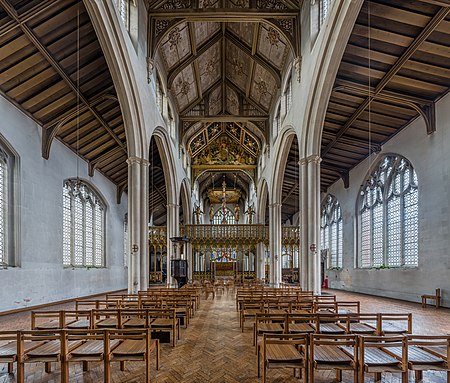
|
|
St Cyprian's, Clarence Gate, is a Church of England parish church in the district of Marylebone in London. The church was consecrated in 1903, but the parish was founded in 1866. Dedicated to Cyprian, a 3rd-century martyr and Bishop of Carthage, it is near the Clarence Gate Gardens entrance to Regent's Park, off Baker Street. The present church was designed by Ninian Comper and is a Grade II* listed building. The parish was formed by the efforts of noted "slum priest" Charles Gutch, who wanted a church of his own in London. Gutch negotiated that a small portion of St Paul's parish be transferred to a new mission district where church attendance was in any case poor. The district was about one-tenth the area of the parish, but it was densely populated due to the overcrowded slums that at that time occupied much of it. This photograph depicts the nave of the church, looking towards the altar in the background. Photograph credit: David Iliff
Recently featured:
|
July 9

|
Haboku sansui (破墨山水図, Broken Ink Landscape) is a splashed-ink landscape painting on a hanging scroll. It was made by the Japanese artist Sesshū Tōyō in 1495, in the Muromachi period. Sesshū Tōyō was a Zen Buddhist monk and painter. The work is a development of suibokuga paintings made with Chinese ink, using dark and light shades on a silk or paper medium. The monochromatic style can result in artworks similar to calligraphy. In spite of its title, the work is not one of "broken ink" (haboku) but rather one of "splashed ink" (hatsuboku). In this style, the painter avoids strongly defined outlines, with shapes indicated by colour washes in lighter and darker tones. Credit: Sesshū Tōyō; photographed by Bamse
Recently featured:
|
July 10
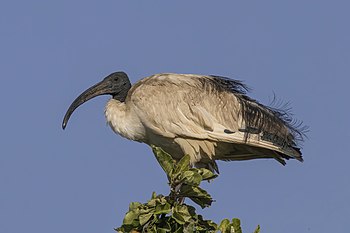
|
The African sacred ibis (Threskiornis aethiopicus) is a wading bird and a species of ibis, of the family Threskiornithidae. The bird, native to Africa and the Middle East, is especially known for its role in the religion of the ancient Egyptians, where it was linked to the god Thoth. Visually, the African sacred ibis has an all-white body plumage, apart from the dark plumes on the rump. This African sacred ibis was photographed in Lake Ziway, Ethiopia. Photograph credit: Charles J. Sharp
Recently featured:
|
July 11
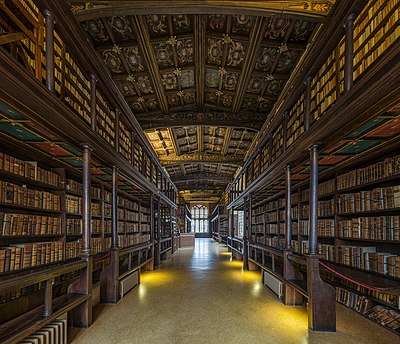
|
Duke Humfrey's Library is the oldest reading room in the Bodleian Library at the University of Oxford in Oxford, England. It is named after Humphrey, Duke of Gloucester, who donated 281 books after his death in 1447. Sections of the libraries were restored and expanded in the 16th and 17th centuries, including the addition of a second storey, and east and west wings. The library currently functions as a reading room. Photograph credit: David Iliff
Recently featured:
|
July 12

|
St. Peter and Paul Cathedral, also known as Brandenburg Cathedral, is the largest medieval church in Brandenburg an der Havel in the German state of Brandenburg. Construction began in 1165 as a Romanesque aisleless church (Saalkirche), and it was later expanded to a three-aisled, Brick Gothic basilica. Its patron saints are Saint Peter and Saint Paul the Apostle. This photograph depicts the cathedral's nave, with white vaulted ceilings and red brick archways, windows, and floor, filled with rows of wooden chairs and golden statues. Photograph credit: Mathias Krumbholz
Recently featured:
|
July 13

|
Dorothy Houston Jacobson (November 13, 1907 – July 13, 1985) was an American political scientist and educator, and a co-founder and chair of the Minnesota Democratic–Farmer–Labor Party. Born in Herman, Minnesota, she served as Assistant Secretary for International Affairs in the United States Department of Agriculture (USDA) from 1964 to 1969, during the Johnson administration, and was the first woman to serve in a sub-cabinet position in the USDA. This 1967 photograph depicts Jacobson seated at her desk at the USDA headquarters in Washington, D.C. Photograph credit: United States Department of Agriculture; restored by Adam Cuerden
Recently featured:
|
July 14

|
The red wattlebird (Anthochaera carunculata) is a passerine bird native to southern Australia. At 33 to 37 centimetres (13 to 14+1⁄2 in) in length, it is the second-largest species of Australian honeyeater. The species is found in open forest and woodland, and is a common visitor to urban gardens and parks. Loud and conspicuous, the red wattlebird is generally found in trees, where it gets most of its food; occasionally it forages on the ground. It is one of the largest nectarivorous birds in the world, feeding from a wide variety of flowering plants, though insects also comprise part of its diet. It is territorial and at times aggressive towards birds of other species, often defending rich sources of nectar. Although it has declined in places from land clearing, it is classified as a least-concern species on the IUCN Red List. Pictures of the day are chosen from the pool of featured pictures on the English Wikipedia. Editors may vote on featured picture candidates here. Photograph credit: Andreas Trepte |
July 15

|
|
NASA space-flown Apollo medallion for the Apollo–Soyuz mission. Apollo–Soyuz was the first crewed international space mission, carried out jointly by the United States and the Soviet Union in 1975. A United States Apollo capsule and a Soviet Union Soyuz capsule launched into orbit on July 15, and millions of people around the world watched on television two days later as the spacecraft docked and the two crews shook hands through the hatch. The project was a symbol of détente between the two superpowers during the Cold War, and it is generally considered to mark the end of the Space Race, which had begun in 1957 with the Soviet Union's launch of Sputnik 1. Credit: Robbins Company for NASA; photographed by Heritage Auctions
Recently featured:
|
July 16

|
|
Joy Young Rogers (1891–1953) was an American suffragist who served as an assistant editor of The Suffragist, the weekly newspaper of the National Woman's Party and the Congressional Union for Woman Suffrage. This photograph depicts her (then Joy Oden Young) outside the White House in Washington, D.C., where she presented President Woodrow Wilson with a basket of flowers that contained a request for the passage of the Nineteenth Amendment to the United States Constitution to allow women to vote in the United States, and letters of support from women of the American West. Photograph credit: unknown; restored by Adam Cuerden |
July 17

|
The murder of the Romanov family, the imperial family of Russia, took place on the night of 16–17 July 1918 in Yekaterinburg. Following the February Revolution, the Romanov family and their servants had been imprisoned in the Alexander Palace near Saint Petersburg before being moved to Tobolsk in Siberia in the aftermath of the October Revolution. They were shot and bayoneted to death by Bolshevik revolutionaries under Yakov Yurovsky on the orders of the Ural Regional Soviet in Ipatiev House. This 1913 photograph of the family depicts the imperial couple and their five children: from left to right, Grand Duchess Olga, Grand Duchess Maria, Emperor Nicholas II, Empress Alexandra Feodorovna, Grand Duchess Anastasia, Tsesarevich Alexei, and Grand Duchess Tatiana. Photograph credit: Levitsky Studio; restored by Wolcott and Yann Forget |
July 18
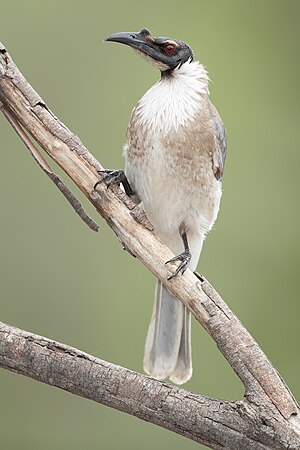
|
The noisy friarbird (Philemon corniculatus) is a passerine bird in the honeyeater family Meliphagidae native to southern New Guinea and eastern Australia. It is one of several species known as friarbirds whose heads are bare of feathers. The species is brown-grey in colour, with a prominent knob on its bare black-skinned head. It feeds on insects and nectar. This noisy friarbird was photographed in Glen Davis, New South Wales. Pictures of the day are chosen from the pool of featured pictures on the English Wikipedia. Editors may vote on featured picture candidates here. Photograph credit: John Harrison |
July 19

|
The Hunting of the Snark is a nonsense poem by the English writer Lewis Carroll, telling the story of ten characters who cross the ocean to hunt a mysterious creature known as the Snark. The poem was published in 1876 with illustrations by Henry Holiday. This is the seventh plate from his illustrations, accompanying "Fit the Fifth: The Beaver's Lesson", in which the Butcher and the Beaver hear the song of the Jubjub bird, and this causes the Butcher to be reminded of his childhood, and begin a lengthy lesson to the Beaver: The Beaver brought paper, portfolio, pens, Illustration credit: Henry Holiday; restored by Adam Cuerden
Recently featured:
|
July 20
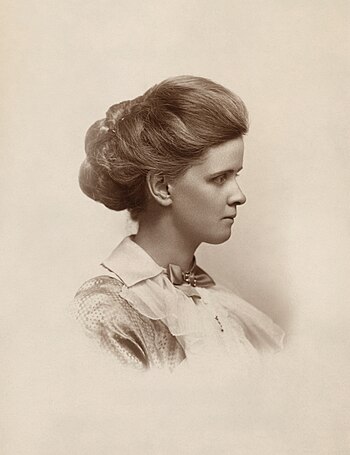
|
Lillian Feickert (July 20, 1877 – January 21, 1945) was an American suffragist and political organizer. She served as the president of the New Jersey Woman Suffrage Association from 1912 to 1920, and later helped organize the New Jersey League of Women Voters. Feickert went on to serve as the vice-chairman of the New Jersey Republican State Committee, and unsuccessfully ran for election to the United States Senate in 1928, the first woman from the state to do so. Photograph credit: unknown; restored by Adam Cuerden
Recently featured:
|
July 21

|
Buzz Aldrin (born 1930) is an American former astronaut, engineer and fighter pilot. He made three spacewalks as pilot of the 1966 Gemini 12 mission, and was the pilot of the Lunar Module Eagle for Apollo 11. On July 21, 1969, he and Apollo 11 mission commander Neil Armstrong became the first two people to step onto the surface of the Moon. This official NASA portrait, taken in April 1969, depicts Aldrin in a white Apollo space suit in front of a large picture of the Moon, with his helmet resting on a pedestal. Pictures of the day are chosen from the pool of featured pictures on the English Wikipedia. Editors may vote on featured picture candidates here. Photograph credit: NASA; restored by Coffeeandcrumbs
Recently featured:
|
July 22

|
Wells Cathedral is an Anglican cathedral in Wells, Somerset, commenced around 1175 on the site of a late-Roman mausoleum and an 8th-century abbey church. The cathedral has been described by the historian John Harvey as Europe's first truly Gothic structure, lacking the Romanesque work that survives in many other cathedrals. It is the seat of the bishop of Bath and Wells. This photograph shows the stairs leading from the north transept to the chapter house. Photograph credit: David Iliff
Recently featured:
|
July 23

|
|
The Argentine real was the currency of Argentina between 1813 and 1881. From 1822, it was subdivided into ten décimos. The sol was also issued during this period and was equal to the real, while the peso was worth eight reales and the escudo was worth sixteen reales. This 1828 eight-escudo gold coin was issued by the United Provinces of the Río de la Plata, a predecessor state of modern Argentina, featuring the Sun of May on the obverse and the Argentine coat of arms and motto (En unión y libertad, 'In unity and freedom') on the reverse. The coin forms part of the National Numismatic Collection at the Smithsonian Institution. Coin design credit: United Provinces of the Río de la Plata, photographed by the National Numismatic Collection
Recently featured:
|
July 24

|
|
The Turgot map of Paris is a highly accurate and detailed map of the city of Paris, France, as it existed in the 1730s. It was published in 1739 as an atlas of twenty non-overlapping sectional bird's-eye-view maps, each approximately 50 cm × 80 cm (20 in × 31 in), in isometric perspective toward the southeast, as well as one simplified overview map – shown here – with a four-by-five grid indicating the general layout of the twenty sectional maps. It has been described as "the first all-comprising graphical inventory of the capital, down to the last orchard and tree, detailing every house and naming even the most modest cul-de-sac". Map credit: Louis Bretez and Claude Lucas
Recently featured:
|
July 25
|
The lion's mane jellyfish (Cyanea capillata) is one of the largest known species of jellyfish, with a range confined to the cold, boreal waters of the Arctic, northern Atlantic, and northern Pacific Oceans. These photographs depict a lion's mane jellyfish in Gullmarn, a fjord on the western coast of Sweden, with its bell alternately expanded (top) and contracted (bottom). The specimen was likely a juvenile, with a bell 10 to 12 centimetres (3.9 to 4.7 in) in diameter and tentacles 60 to 80 centimetres (24 to 31 in) in length. The largest recorded individual of the species had a bell approximately 210 centimetres (7 ft) wide and tentacles around 36.6 metres (120 ft) long. Photograph credit: W.carter
Recently featured:
|
July 26
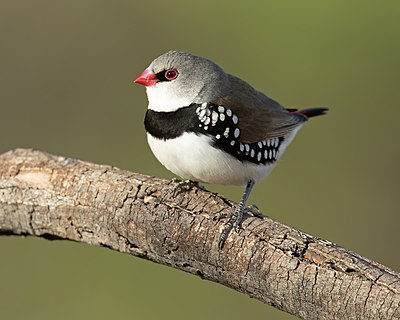
|
The diamond firetail (Stagonopleura guttata) is a species of estrildid finch that is endemic to Australia. The species generally inhabits drier forests and grassy woodlands west of the Great Dividing Range, and can be distinguished by a black band on a white breast. Their flanks are black with white spots with a scarlet rump and a black tail. This diamond firetail was photographed in Glen Alice, New South Wales. Photograph credit: John Harrison
Recently featured:
|
July 27

|
Ice speedway is a form of motorcycle-speedway racing on frozen surfaces. The sport uses specialised bikes that race anticlockwise around oval tracks between 260 and 425 metres (853 and 1,394 ft) in length, with a race structure and scoring similar to that of speedway racing. This photograph depicts the German speedway racer Max Niedermaier practising in Inzell, Germany, for the finals of the 2018 Individual Ice Racing World Championship, organised by the sport's governing body, the Fédération Internationale de Motocyclisme. Photograph credit: Walter Isack
Recently featured:
|
July 28
Silver certificates are a type of representative money issued between 1878 and 1964 in the United States as part of its circulation of paper currency. They were produced in response to silver agitation by citizens who were angered by the Coinage Act of 1873, which had effectively placed the United States on a gold standard. Since 1968 they have been redeemable only in Federal Reserve Notes and are thus obsolete, but they remain legal tender at their face value and hence are still an accepted form of currency. This is a complete set of the 1899 series of large-size silver certificates, designed by the Bureau of Engraving and Printing and comprising three denominations from $1 to $5. Each banknote bears the engraved signatures of Judson Whitlocke Lyons (Register of the Treasury) and Ellis H. Roberts (Treasurer of the United States), and a portrait of a different individual or individuals, identified above. Banknote design credit: Bureau of Engraving and Printing; scanned by Godot13
Recently featured:
|
July 29
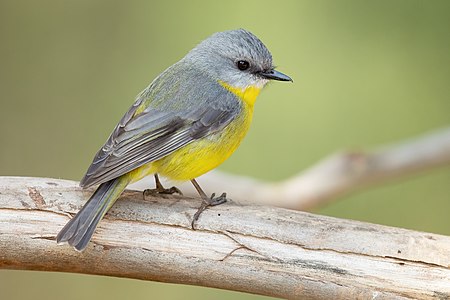
|
|
The eastern yellow robin (Eopsaltria australis) is an Australasian robin found in coastal and sub-coastal eastern Australia. The extent of the species's residence is from the extreme southeast corner of South Australia through most of Victoria and the western half of New South Wales and north as far as Cooktown. Birds in tropical northern Queensland are mainly restricted to the warm heights of the Great Dividing Range. This eastern yellow robin was photographed in Yengo National Park, New South Wales. Photograph credit: John Harrison
Recently featured:
|
July 30
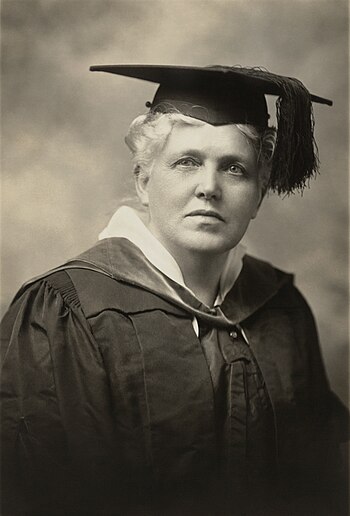
|
Emma Gillett (July 30, 1852 – January 23, 1927) was an American lawyer and women's rights activist who played a pivotal role in the advancement of legal studies for women. Photograph credit: Edmonston, Washington, D.C.; restored by Adam Cuerden
Recently featured:
|
July 31

|
Ada Flatman (1876–1952) was a British suffragette in the United Kingdom and the United States. She was sent to Holloway Prison after taking part in the "raid" on the Houses of Parliament in 1908, led by Marion Wallace Dunlop, Ada Wright and Katherine Douglas Smith, and a second wave by Una Dugdale. The following year she was employed by the Women's Social and Political Union (WSPU) to organise their activities in Liverpool, taking over from Mary Phillips. In July 1910, Flatman was a key speaker at one of the platforms in the 10,000 women rally at Hyde Park, London. She worked with Alice Stewart Ker, but it was Flatman who was trusted by Emmeline Pethick when Liverpool requested that they be allowed to open a WSPU shop. The shop was set up for her by Patricia Woodlock and became a success, raising substantial funds for the cause. Flatman organised the publicity surrounding the release of Woodlock, who had completed a prison term in Holloway. Photograph credit: Harris & Ewing; restored by Adam Cuerden
Recently featured:
|
Picture of the day archives and future dates

